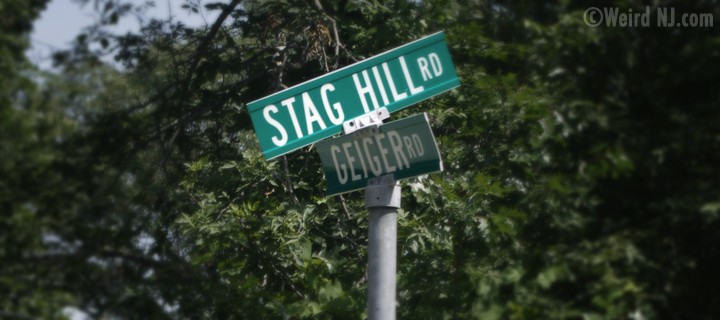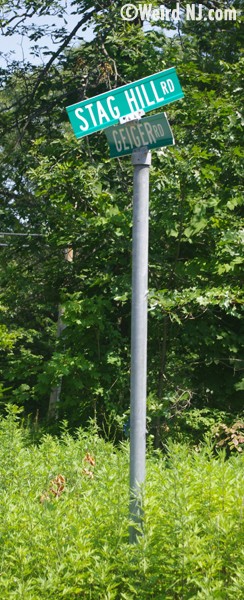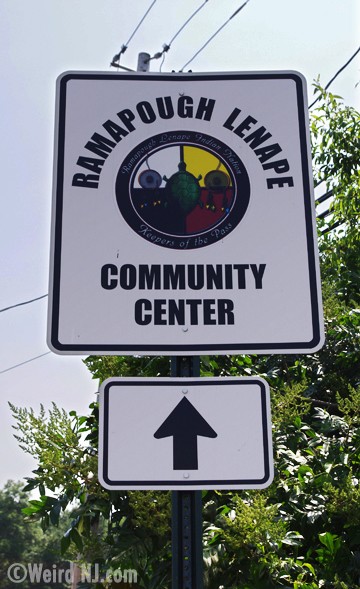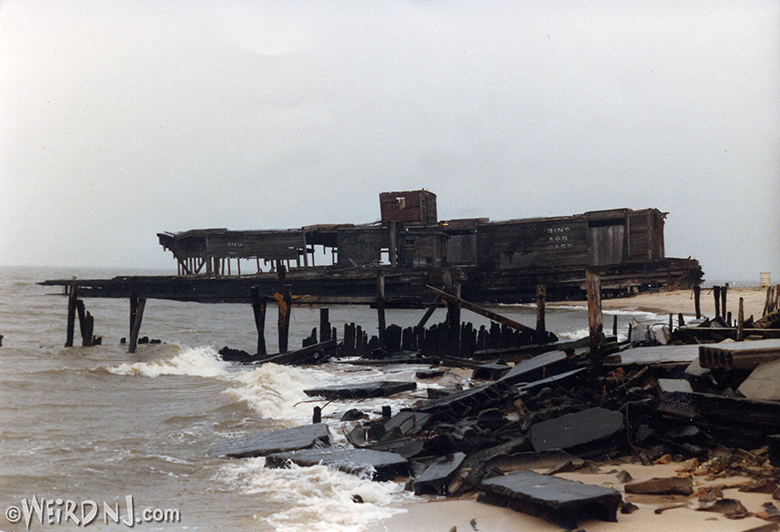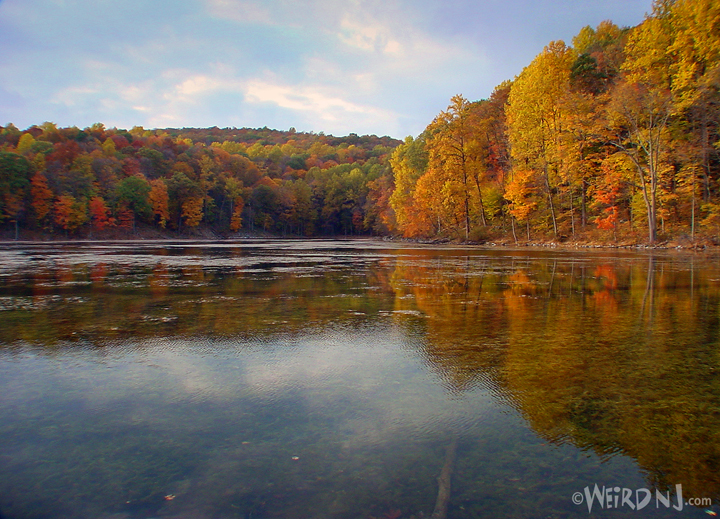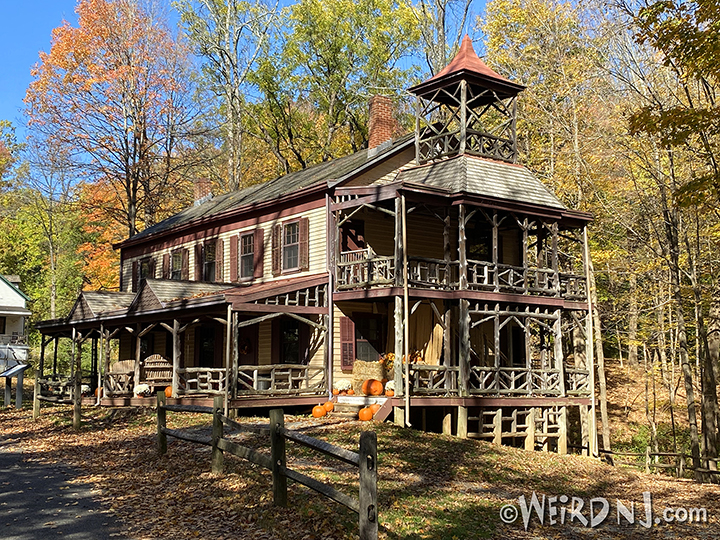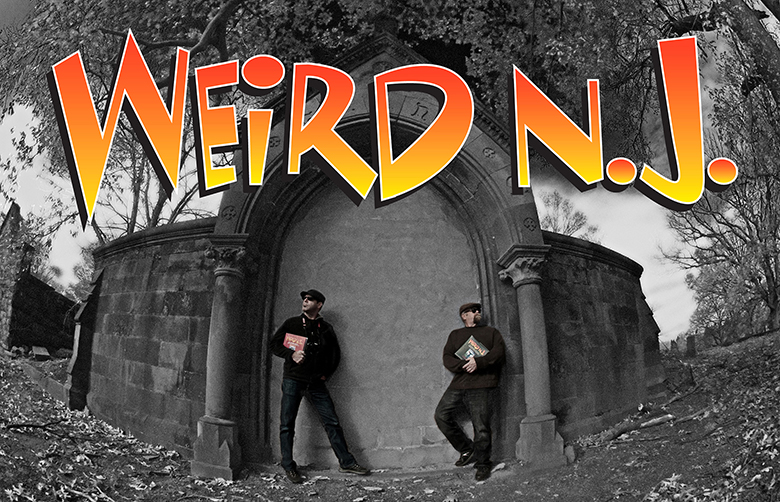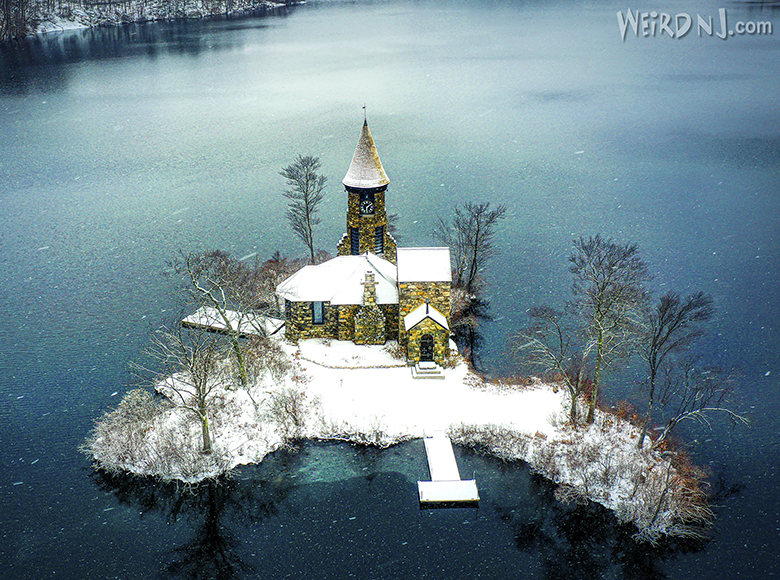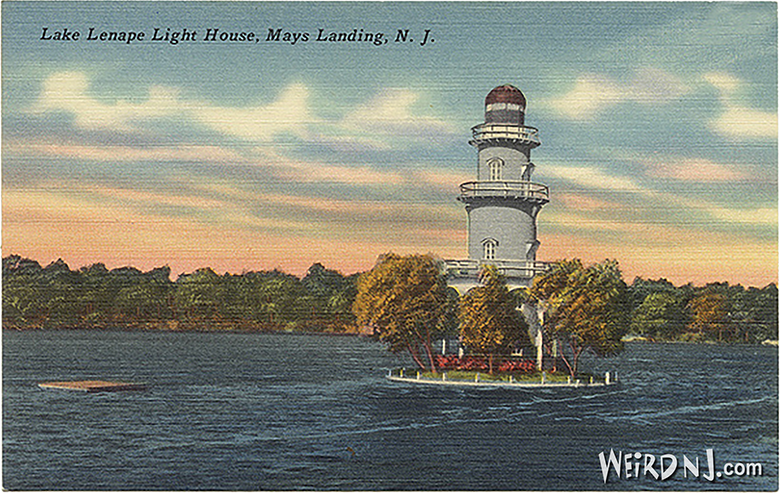History and Legends of the Mysterious “Jackson Whites”
Ever since the Revolutionary War there have been stories of a degenerate race of people who live an isolated existence in New Jersey’s Ramapo Mountains. This motley group of social outcasts who had taken refuge in the northeastern hills of the state and inbred to the point of mutation. The group, which has been alleged to be comprised of a mongrel hybrid of renegade Indians, escaped slaves, Hessian mercenary deserters, and West Indian prostitutes, have come to be known as the Jackson Whites.
For many years now there have been stories of a degenerate race of people who live an isolated existence removed from the civilized world in New Jersey’s Ramapo Mountains. As far back as the revolutionary war New Jerseyans have heard, and told, tales of a motley group of social outcasts who had taken refuge in the northeastern hills of the state and inbred to the point of mutation. The group, which has been alleged to be comprised of a mongrel hybrid of renegade Indians, escaped slaves, Hessian mercenary deserters, and West Indian prostitutes, have come to be known as the Jackson Whites.
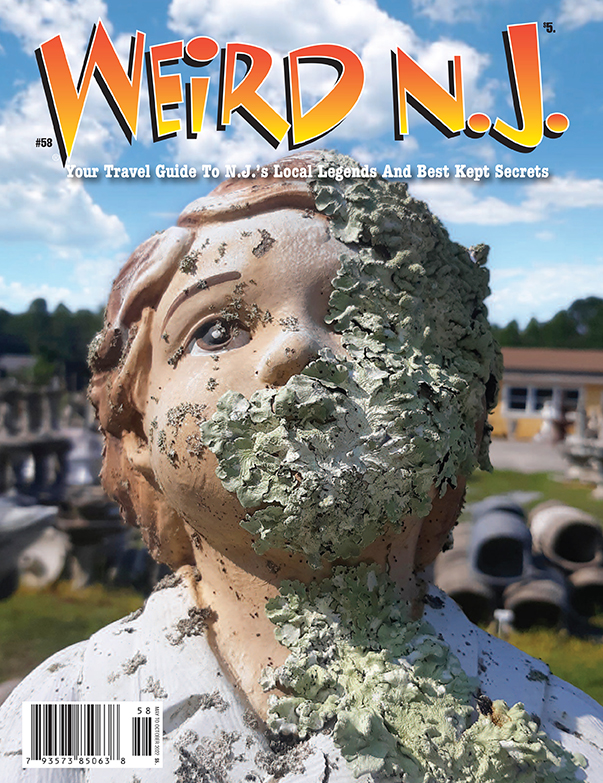 Probably the most puzzling question about this mysterious Jackson Whites clan is not who they are, but what the origins of their legend is. Most commonly associated with the Ramapo Mountain peoples of Mahwah, Ringwood, and the southern New York state towns of Hillburn an Suffern, the moniker “Jackson Whites” is now, and has almost certainly always been used as a derogatory name. Who the term refers to, and how it has endured for over two centuries until the present is most likely due to some less than scholarly historical texts that have either inadvertently or knowingly transcribed local legends as authenticated fact.
Probably the most puzzling question about this mysterious Jackson Whites clan is not who they are, but what the origins of their legend is. Most commonly associated with the Ramapo Mountain peoples of Mahwah, Ringwood, and the southern New York state towns of Hillburn an Suffern, the moniker “Jackson Whites” is now, and has almost certainly always been used as a derogatory name. Who the term refers to, and how it has endured for over two centuries until the present is most likely due to some less than scholarly historical texts that have either inadvertently or knowingly transcribed local legends as authenticated fact.
Probably the earliest written reference to the Ramapo Mountain People to be found is contained in an article entitled “A Community of Outcasts” in Appleton’s Journal of Literature, Science and Art, dated March 23, 1872, which read:
“In relation to this particular people, there are half a dozen legends current, all possessing more or less romance and attractiveness; but the most favored one is, for a rarity, the most reasonable.
The people will tell you that this stain upon their fair country was first put there by fugitive slaves, more than a hundred years ago.
There was gradually added to these fugitive slaves, fugitives of other descriptions, and the general antagonism to the world made each individual endure the others. They buried themselves deep in the fastnesses and gorges of the mountains, and reared children, wilder and more savage than themselves.”
An early literary reference to the Ramapo people as “Jackson Whites” dates back to 1900 in J.M. Van Valen’s History of Bergen County, which states:
“The Ramapo Indians sometimes visited the settlements in the township of Franklin. They were known formerly as the Hackensack Indians, but are more properly described the “Jackson Whites.” They bear little resemblance to the Indians, yet as tradition gives it they are descendants of Hessians, Indians, and Negroes, but know nothing of their ancestry, so ignorant have they become.”
Arthur S. Tompkin’s 1902 History of Rockland County, New York, told the saga of the Jackson Whites this way:
“The Jackson Whites originated when the Indians were yet living in the lowlands along the Ramapo Mountains. The first race came by a union between the Indians and half breeds on one side, and colored laborers brought from the lower part of the county to work in the Ramapo factories on the other side. The colored people were either freed slaves or their children grown up, and many of the names today may be traced as identified with some of the old Holland pioneers of Orangetown, for the slaves in old times bore the surnames of their masters. Inter-marriage among these people has caused them to degenerate intellectually if not physically.”
In 1906-7 the New Jersey historical society’s annual report contains this passage explaining the Jackson Whites curious lineage:
“The Secretary wrote that his understanding had been that they [the Jackson Whites] were a people of mixed Indian and Negro blood, the Indian strain showing in their reticence, and the Negro strain in their indolence and improvidence. They are supposed to be the offspring of former Negro slaves, runaways, and free Negroes, who sought refuge in the mountains where they could eke out a living by cutting hoop-poles and wood for charcoal, in the days of charcoal iron furnaces. They have been regarded as outcasts, and hence have been allowed to sink into a degraded state…”
In 1911 the Jackson Whites’ story took on a pseudo-scientific authority when a University of Pennsylvania anthropologist named Frank Speck published an article that claimed that:
“Algonquian Indians, probably Minisinks of the Delaware, with some of the Tuscarora who lingered for a rest in the Ramapo Valley on their way from Carolina in 1714 to join their colleagues, the Iroquois, in New York State. To this small nucleus became added from time to time runaway Negro slaves and perhaps freed men from the Dutch colonial plantations in the adjoining counties in New Jersey. Vagabond white men of all sorts also contributed a share to the community from the early days until now. The Jackson Whites may be regarded, therefore, as a type of triple race mixture.”
Also written that same year was an even less well researched study by the head of New Jersey’s Vineland Training School, Henry Herbert Goddard, entitled, The Jackson Whites: A Study in Racial Degeneracy. Taking his liberties with the history of the Ramapo’s inhabitants, Goddard gave his own slant to their lineage.
“These loose living descendants of slaves were gradually crowded back into the mountain districts where they lived from hand to mouth and where their numbers were from time to time recruited by whites whose tendencies were similar to their own…But how account for the Indian blood that shows itself so conspicuously among this race today? Undoubtedly a large part of it comes form Indians who were formerly held as slaves…
The Indian blood found in the Jackson Whites whether it came down through individuals held as slaves or through isolated free Indians who intermarried with the emancipated Negroes, is supposed to have belonged to a remnant of the Algonquin Tribe-to the Minsi, or Wolf Clan, who were natives of the Upper Delaware Valley in Pennsylvania, New Jersey, and New York… there were also a few families of the Tuscarora Indians who remained in the Ramapo mountains after their tribe had made there a three years sojourn, from 1710 to 1713, on its way to joint the five nations in New York State.”
It is worth mentioning here that Henry Herbert Goddard is also the man responsible for the 1912 book entitled The Kallikak Family, in which he documented his study of “hereditary feeble-mindedness” in a particular New Jersey Pine Barrens clan of his own creation.
The single document that was probably most responsible for solidifying the Jackson Whites’ legend in New Jersey folklore was a self published 1936 book entitled The Origins of the Jackson Whites of the Ramapo Mountains by John C. Storms. Relying more heavily upon the day’s prevailing mythology than on any personal investigation, Storms, a small town newspaper editor, exercised his well known penchant toward over embellishment and romanticism. It was Storms’ contention that Tuscarora Indians, who had fled North Carolina after a war with white settlers which had lasted from 1711 to 1713, were the first ingredient in a racial stew of people that would come to be known as Jackson Whites. According to Storms’ booklet:
“Originally the Ramapo Mountain region was a favorite resort of the Hagingashackie (Hackensack) Indians, part of the Leni Lenape family of the Iroquois [in fact, they were part of the Algonquin, not the Iroquois, language group]…These aborigines had practically all disappeared by the end of the seventeenth century. However, a few remained together with a scattered population that had sought the security of the mountains to evade their brother white man, his laws and customs. Thus it was a sort of No Man’s Land.
The first real influx of a permanent population in the Ramapo Mountains was in 1714. This was a remnant of the Tuscarora Indians…Arrived at the Ramapos a stop was made for a time; perhaps it was because there were to be found congenial spirits among the remaining Hagingashackies and the wild renegades who were hiding there. But the ultimate object was to unite theirs with the powerful Five Nations that ruled the country to the northward…”
The second strain in the Jackson Whites’ bloodline, according to Storms, was contributed by Hessian mercenaries fighting for the British during America’s Revolutionary War.
“Reaching America under duress, placed in the forefront at every important battle in which they were engaged, beaten by their officers with the broadside of swords if they attempted to retreat, made to do the menial labor of their British companions, their fate was a particularly cruel one. With no interest in the outcome of the military struggle, unfamiliar with the theory of ‘liberty’ for which the Americans were fighting, it is not to be wondered at that they proved unfaithful, and deserted the army at every opportunity.
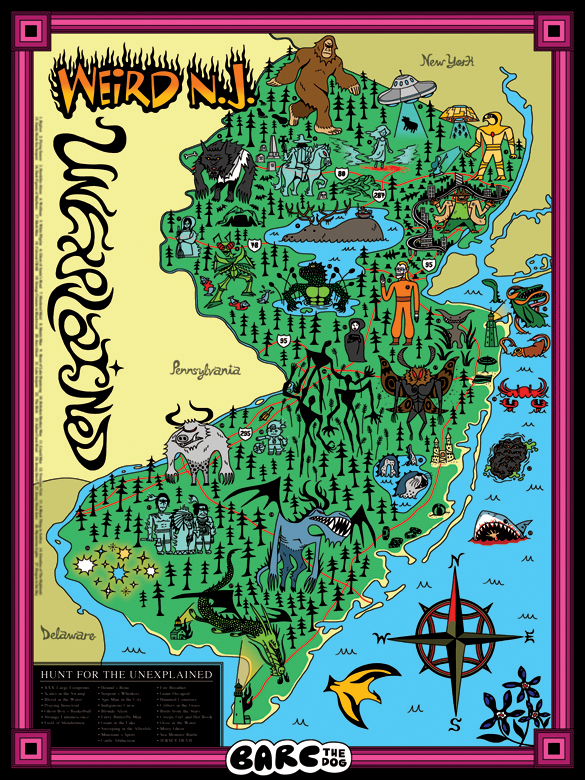 In the fighting that took place in the vicinity of New York City, from the camps scattered throughout this region, and at the marches across New Jersey, these men, known by the general name of Hessians, fled to the nearest place of safety – the Ramapo Mountains. There was no possibility of escape, no opportunity to return to their native land, so they made for themselves homes in their retreat, mated with those they found already there, and reared families.”
In the fighting that took place in the vicinity of New York City, from the camps scattered throughout this region, and at the marches across New Jersey, these men, known by the general name of Hessians, fled to the nearest place of safety – the Ramapo Mountains. There was no possibility of escape, no opportunity to return to their native land, so they made for themselves homes in their retreat, mated with those they found already there, and reared families.”
The third genetic element in the Jackson Whites’ lineage, as professed by Storms was derived from English and West Indian Women who were forcibly brought to New York to serve as concubines for British soldiers.
“The British War Office had a problem on its hands – keeping New York City loyal to the Crown as a Tory city, while keeping thousands of its soldiers in the military camp that General Clinton had established there…
But there was a way out of the difficulty, a way that had long been in vogue by warring European nations, in fact, by England herself. A little judicious questioning and a man was found who would accept the undertaking. The man’s name was Jackson – history has not preserved for us anything more about him than this, not even his given name.
A contract was entered into that Jackson was to secure thirty-five hundred young women whom England felt it could very well dispense with, and transport them to America to become the intimate property of the army quartered in New York City, thus relieving the tension now felt that at any moment these same soldiers might take to themselves such of the residents as temporarily pleased their fancy…
Jackson set his agents at the task of recruiting from the inmates of brothels of London, Liverpool, Southhampton and other English cities along the sea coast…If a young woman or matron chanced to be on her way home from her occupation, or on the street on an honest mission she fared the same fate as the inmates of the houses of ill fame, and many a respectable working girl or young housewife was shanghaied, and carried off to a life of shame across the sea.
Jackson loaded his human cargo into vessels in the harbors, forced them below decks and battened down the hatches to prevent escape, even from suicide by leaping overboard. Every available vessel that was seaworthy was in use to transport soldiers and supplies for the army, none could be spared except the merest hulks. Twenty of these Jackson used. All set sail for America, but on the way across the ocean a violent storm arose. Some of the vessels became separated from the others. At last, one by one they reached New York – nineteen of them. Somewhere one had foundered in mid ocean, carrying down to a more merciful fate fifty women and the entire crew…
Accordingly, one vessel was dispatched to the West Indies, most accessible British possession, loaded with negresses collected in the same manner as the others had been, and brought to New York.
…Lispenards Meadows [a low, swampy, salt meadow on the west side of Manhattan near the present entrance to the Holland Tunnel] had been secured as quarters for the anticipated “guests,” and was being duly prepared….”
In 1783, when New York was repatriated by American Army forces, the stockade of women was evacuated and the prisoners beat a hasty retreat along with British soldiers and Tories.
“Suddenly someone remembered the hundreds of English women imprisoned at Lispenard’s Meadow…A hurried order was given, a messenger rode pell mell to the Meadows, unbarred and threw open the big gate of the stockade, and hurried back to escape from the city with his companions…Out of the stockade gate poured the motley throngs of women, after several years of confinement in their noisome quarters.
By far the larger portion of the human stream that flowed out of Lispenard’s Meadows on that eventful Evacuation Day of 1783, by some unknown means, reached the western shore of the Hudson… the horde has been estimated at about three thousand or slightly more… To the company was added a few soldiers who preferred to cast in their lot with the refugees, having formed a quasi-attachment for some member of it. Tories, too, who had been unable to secure passage to the Canadian ports considered their bodily safety rather than their social standing…Then, too, the confusion of departure afforded an added opportunity for a number of Hessians to make their escape…
Then followed another memorable trek. Across the Hackensack Meadows, up the Saddle River valley, these derelicts made their way on foot….Pillaging of orchards and deliberate raids on fields and gardens provoked the farmers, who drove the wanderers on with hard words and often with harder blows, all of which was retaliated. No one wanted these unfortunates…
At last, with Oakland past, the crowd entered the Ramapo Pass and soon found itself in a country that, while wild and inhospitable in character, yet offered the boon of peace; there was no one to drive them away. Here the colony scattered, finding shelters in the woods and among the rocks. Here the individual members found companionship of peaceful Indians, escaped outlaws, Hessians, runaway slaves — there was ample companionship and it was readily accepted.”
Storms cites a New York Tory newspaper known as Rivington’s Loyal Gazette, as the first publication to coin the name “Jackson Whites.”
“In these columns occur references of visits paid by various companies of soldiers to “Jackson’s Whites,” and sometimes to “Jackson’s Blacks.” These sly hints are made in a jocular vein, seem to carry no stigma, reproach, or violation of military discipline. The term “Whites” and “Blacks” following Jackson’s name quite clearly show to which group of inmates of the stockade the visitor’s attention was paid.”
It would be escaped slaves, who, according to storms would contribute the final piece to the Jackson Whites’ ancestral puzzle.
“The Dutch settlers kept these bondsmen as servants principally, and the bondage was not particularly hard in most cases. Still, it frequently happened that these escaped slaves would seek their own freedom, and the most accessible place and most secure was the fastness of the Ramapos…These people carried with them names of former masters, white acquaintances, or those that they had adopted. Thus we sometimes find family names among them that are borne by prominent and socially acceptable white persons.”
How much of Storms’ account of the Ramapo Mountain People’s origins is historically accurate, and how much was merely transcribed from oral folk tales of the Jackson Whites is unclear. It is certain, however, that his “evidence” influenced people’s perceptions of the Ramapos’ residents and tainted many supposedly scholarly works that would follow. As if it was not damaging enough that the stereotypes, propagated by the various “authoritative” studies, had permeated the public’s consciousness, subsequent literary references to the Jackson Whites actually reinforced the mythology. The famous canine story writer, Albert Payson Terhune of Pompton Lakes, vilified his mountain dwelling neighbors in his 1925 book, Treasure. And in his epic 1947 poem, ‘Paterson,’ William Carlos Williams concocted his own version of the Jackson Whites legacy, drawing obvious inspiration from the Storms history.
“Violence broke out in Tennessee, a massacre by the Indians, hangings and exile…The Tuscaroras, forced to leave their country, were invited by the Six Nations to join them in Upper New York. The bucks went on ahead but some of the women and the stragglers got no further than the valley-cleft near Suffern. They took to the mountains there where they were joined by Hessian deserters from the British Army, a number of albinos among them, escaped Negro slaves and a lot of women and their brats released in New York City after the British had been forced to leave. They had them in a pen there – picked up in Liverpool and elsewhere by a man named Jackson under contract with the British Government to provide women for the soldiers in America.
The mixture ran in the woods and took the general name, Jackson’s Whites. (There had been some blacks, also, mixed in, some West Indian negresses, a ship-load, to replace the whites lost when their ship, one of six coming from England, had foundered in a storm at sea…)”
In the end there is not much historical evidence to support any of these versions of the Jackson Whites’ legend. The Ramapo Mountain People themselves will tell you a variety of stories to explain their own ancestry, intertwining elements of the Dutch, Hessian, and Tuscarora Indian sagas into their own legacy. How much of these peoples’ accounts of their history has been passed down from their forebearers, and how much has been tainted by the repeated publication of various texts on the subject is unknown. Most insist that they are really a tribe of Indians called the Ramapough. Though they bare little physical resemblance to Native Americans (most appear to be light-skinned African-Americans), they have been petitioning the Federal Government for 20 years to be recognized as a legitimate American Indian tribe. They have been recognized by the state governments of New Jersey and New York as such, but the federal Bureau of Indian Affairs has denied their petitions.
Such recognition is considered crucial because it brings certain Federal benefits, such as housing and health care assistance and the right to operate a casino. According to the Bureau though, the Ramapoughs are not a tribe at all, but rather descendants of settlers with African and Dutch blood who moved to the area from Manhattan in search of farmland beginning in the late 1600’s.
The Bureau asserts that they have failed to show that they are descendants of a historic Indian tribe and cannot prove that they have led a continuous existence as a separate band of people since the time of their first contact with Europeans.
It is almost certain that the legends of the Jackson Whites were originally started by the white neighbors of the Ramapos to stereotype the mountain people in a derogatory fashion. While their Ramapough show a fierce pride in their unique identity you would be hard pressed to find a person in Mahwah, Ringwood, or Hewitt that would call him or herself a Jackson Whites. “Those people,” it would seem, are always to be found just over the next mountain.
After our original article concerning the Jackson Whites’ legend was published we received a lot of mail in regard to the piece. Many of the letters sounded quite angry, as though we were in some way responsible for the existence of the legends, rather than merely their documentarians. Some of the mail was actually threatening, as many residents of the region seemed to have a difficult time separating the defamatory reputation of the Jackson Whites, from the historical legacy of the Ramapough Indians. The following letters from our readers may help illustrate how people in the Ramapo Mountains see themselves, and how they are perceived by others today.
From a Friend of the Jackson Whites
You may hear a lot of legends but if you were to meet some of these people they’d share their food and drink and they’d make you part of a friendship, which is deep and will always be there for you. They don’t take you and make you disappear deep in the woods. They’re not kidnappers. They don’t rape or kill people.
Their men are tall, big and strong. They provide for their families and the women love their children. The kids grow up together and it’s a shame because of all this kind of publicity they get cornered out. They don’t belong. That’s how they grow and feel about the outside world. You probably work with one and don’t even know it. All they are are mixed breeds just like us. None of us are really American. At least they have the American Indian blood in their veins despite how it got there.
I know because I date a Jackson White. My boyfriend worked for nine years in the same place. Takes care of my two girls which was from my previous ex and expects nothing back. He’s never hit or yelled at me for anything in the past 5 years. He’s honest and trust worthy and doesn’t go out cheating and is always home helping with cooking, cleaning, etc. And I’m NOT MISSING in the woods. This man can fix, build, paint, figure out anything and shouldn’t be hurt over an article subjecting Jackson Whites as ghouls.
I’ll take you to meet them any day and bring your cameras. You’ll find they are proud people. May not have a lot of money, but they have electric, cable, water, phones, etc. You should also see the Christmas lights at Christmas time. Does this sound like a bunch of Hillbillies hiding out in the woods to you? –A Friend and Family Member of the Jackson Whites
As Normal As You Are
How do people get the idea that the people of the Ramapo Mountains were murderers? These people were not murderers and they are normal like you and me. I am a science major at Stanford. I have studied things about New Jersey since I was a child. The name came about when back in the 1800’s slaves that were shipped here for slavery and were raped by their “masters.” These people were not inbred. The name Jackson came about when the man who had started it all whose last name was Jackson. These did not result in people being mentally retarded or any abnormalities. You can read all the books and articles you want but I think I would know more about them because I am a Ramapo Mountain Indian and I am as normal as you are. –Evelyn
Those Beautiful Mountain People
Growing up in Suffern and having spent much time in nearby Mahwah, my own observation of the so-called “Jackson Whites” is that they are a very peaceful and beautiful people, but living without many modern amenities. Of course, their community had its share of alcohol and fighting incidents, but the percentage of these incidents (compared to their numbers) never seemed particularly notable. I do remember that many of the Jackson White women were very beautiful, with slender and yet very strong bodies, strong straight shoulders, incredible slate-grey eyes which could stop you in your tracks, and a beautiful light tan skin color.
Simply due to the very different lifestyles, and to the wide difference in income level between the two groups, there was some residual animosity and fear toward the Jackson Whites from the recently-emigrated “suburban dwellers” in Mahwah, Ramsey and Suffern. This fear created some hostile folklore about the Jackson Whites, much of it untrue. –Vinny
Defending the Jackson Whites (?)
I went to school with these people. They work for the Wanaque Reservoir, drive our school buses, were our lunch aids in our elementary schools, and are overall a big part of our community. Granted they are their own people. If you don’t bother them, they aren’t gonna bother you. How would all of you people like it if your home and family were known as freaks of nature? All of their lives they were looked at as dangerous or made fun of for poverty or inbreeding.
A couple of interesting facts I learned from talking to my Jackson-White schoolmate in high school was that they do in fact inbreed, or have done so in the past, but usually only with cousins. Also the police only go up there if someone is dead because they will be attacked under other conditions.
Most of them never finish high school, but two out of the five with whom I grew up, and who were in my grade, finished high school and one of those two is now in college! The women are the people who usually don’t finish high school, and it’s usually because they get pregnant.
Anyway, it has really bothered me to hear that people are traveling up there and bothering them. I mean they’re human too. Oh, and about that electricity, they have phones and cable. Which is more than I have. I have a phone and electricity, but no cable! –Liz from Caldwell College
A Brief History of the Ramapoughs, by the Ramapoughs
By Dan DalCais, MSW, LSW Director, US Title IX, Indian Education Program
In 1709, the Tappan-Hackensacks Indians were unified under one chieftaincy in the Ramapo Mountains. They would remain hidden in the roughest, and to the settlers, the least desirable part of their homeland.
The Tappan-Hackensacks are today called Ramapough Mountain Indians. They are of the northern branch of Lenape or Delaware Indians. This northern branch is known today as Munsee Delawares. The truth is, their community survived because their poverty and isolation protected them from intruders. Outsiders learned little about them. That’s the way it had to be.
The fact is, there is so much historical documentation supporting the Native American heritage of this community that it requires dozens of pages to present a fair review. Another fact is that the vast majority of the public are totally unaware of this. There are many reasons why this is so. One reason is that the decades of denigrating, slandering and mocking these people are not easily overcome. It continues today. It seems there are those who just can’t let go of the notion that this group is fair game for all sorts of vicious gossip.
Also, overwhelming political pressure has been brought to bear against the Ramapough Mountain Indians’ quest for recognition. The Atlantic City gambling industry sees a recognized tribe in New Jersey as a threat to their monopoly. They have invested considerable effort to insure that the Ramapoughs never get a fair hearing. The public’s ignorance of and prejudice against this community have been skillfully exploited. Prejudices and now politics have prevented the truth from being widely known.
Like most Indians they struggle to find a balance between developing their long suppressed identity and making a living in the modern world. All of them are human beings who deserve the same respect as the rest of us. I feel honored to work amongst and be friends with quite a few Ramapough Indians. There are still many Van Dunks, DeFreeses, Manns and DeGroots living in their ancestral mountain homeland. A few even have those blue “Dutchman’s eyes.”
The preceding article is an excerpt from Weird NJ magazine, “Your Travel Guide to New Jersey’s Local Legends and Best Kept Secrets,” which is available on newsstands throughout the state and on the web at www.WeirdNJ.com. All contents ©Weird NJ and may not be reproduced by any means without permission.
Visit our SHOP for all of your Weird NJ needs: Magazines, Books, Posters, Shirts, Patches, Stickers, Magnets, Air Fresheners. Show the world your Jersey pride some of our Jersey-centric goodies!
Now you can have all of your favorite Weird NJ icons on all kinds of cool new Weird Wear, Men’s Wear, Women’s Wear, Kids, Tee Shirts, Sweatshirts, Long Sleeve Tees, Hoodies, Tanks Tops, Tie Dyes, Hats, Mugs & Backpacks! All are available in all sizes and a variety of colors. Visit WEIRD NJ MERCH CENTRAL. Represent New Jersey!

